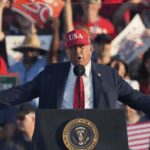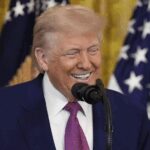This is an audio transcript of the FT News Briefing podcast episode: ‘US consumers start pinching pennies’
Marc Filippino
Good morning from the Financial Times. Today is Friday, August 9th and this is your FT News Briefing.
[MUSIC PLAYING]
Investors seem more optimistic about the US economy, but US consumer spending is slowing and taking a bite out of corporate earnings. Plus, Ukrainian troops captured territory inside Russia this week. The FT’s Chris Miller says it’s Kyiv’s biggest push into Russian territory so far.
Christopher Miller
Ukraine is trying to change the conversation, certainly trying to seize some momentum.
Marc Filippino
I’m Marc Filipino and here’s the news you need to start your day.
[MUSIC PLAYING]
We got more proof yesterday that the stock market sell-off earlier this week was, in fact, a bit of an overreaction. New data show that there were fewer jobless claims in the US last month than expected. Now remember, the whole reason we saw global stocks tumble is that we got alarming US unemployment numbers last Friday. People have been worried since then that the economy was headed towards a recession. The job numbers from yesterday seemed to calm everyone down, though, and then some. The S&P 500 jumped 2.3 per cent. That is its biggest gain since November 2022.
[MUSIC PLAYING]
Now, even though there was some good news about the American workforce yesterday, overall consumer spending has been declining. Just take a look at corporate earnings from this week. Disney pretty much said its theme parks aren’t the most magical place on Earth any more. That’s led to a 3 per cent decline in operating profits. And Airbnb, they’re finding that people are sticking to staycations instead. The FT’s Gregory Meyer has been looking into why folks are tightening their belts, and he joins me now. Hey, Greg.
Gregory Meyer
Hi. Thanks for having me.
Marc Filippino
Yeah, good to have you. So tell me, what signs have you been seeing that made you think, you know, people just aren’t opening their wallets as much any more.
Gregory Meyer
Well, let’s start with McDonald’s. I went to McDonald’s last week in Arkansas, where the sign outside advertised a $5 meal deal. That’s new. That was rolled out in late June. And the company’s explicitly offering that deal at a low price to try to bring customers back in their doors because they have less money to spend. You’re seeing similar things elsewhere. Walmart has got what they call rollbacks or price cuts for 7,000 items across their stores. Target followed with similar cutbacks, as they’re trying to revive sales volumes that have fallen in the past year. There are signs in the data that companies are reporting, and it’s broadly showing that the US consumer that was spending very freely in the years immediately following the onset of the pandemic, they’re getting stretched and they’re getting more hesitant to open their wallets.
Marc Filippino
Yeah. Let’s take a step back. What happened with the pandemic?
Gregory Meyer
Well, I mean, as you remember, in the early months of the pandemic, everybody was stuck at home. They were unable to go out for dinner, they were unable to travel. And also many households in the US received substantial stimulus money. And so they built up their savings in a big way. And as life started to open back up, consumers began to spend freely in spite of strong inflation until quite recently.
Marc Filippino
But now that spending is drying up, and that’s maybe bad news for the US economy, since it’s so largely driven by people buying stuff. So I guess I’m wondering what’s causing this shift.
Gregory Meyer
What’s causing this shift is that the excess savings built up with the pandemic have been largely depleted for many households, especially for lower-income households. And at the same time, the Federal Reserve, in an effort to tamp down the inflationary spike we saw a couple of years ago, has been progressively raising interest rates and held them there at above benchmark interest rates above 5 per cent now for quite a while. That’s making just the cost of money more expensive to take out a mortgage, to buy a house, to take out a loan, to buy a car, to expand a business. In turn, that’s putting pressure on consumers and they’re pulling back.
Marc Filippino
So what could get people out shopping and spending again?
Gregory Meyer
One thing that these consumer businesses are hoping will reverse the trend is their efforts to lower prices or offer special deals and promotions, like you’re saying at McDonald’s, to bring people back in the door. And some of those are showing early signs of success. At a more macro level, as we see the inflation trend fall, there’s mounting expectation that the Fed will finally begin to start cutting rates again, perhaps as soon as its meeting next month. That, in turn, would begin to lower borrowing costs and potentially ease burdens on businesses and on households.
Marc Filippino
Greg Meyer is the FT’s US consumer editor. Thanks, Greg.
Gregory Meyer
Thank you.
[MUSIC PLAYING]
Marc Filippino
Ukraine has mounted a surprise counteroffensive in the Kursk region of Russia, where it seized hundreds of square kilometres of territory. Chris Miller is the FT’s Ukraine correspondent. He’s been covering the counteroffensive and he joins me now. Hey, Chris.
Christopher Miller
Hey, there.
Marc Filippino
All right, so, we’re talking to you Thursday evening in Ukraine. What do we know about the operation so far?
Christopher Miller
Well, it’s a very fluid operation, but it is absolutely a larger counteroffensive than we have seen Ukraine pull off in many months, at least a year. It started on Tuesday. We knew nothing about it. Russia obviously knew nothing about it. Ukraine blew through their border defences, took up positions inside of Kursk region and managed to secure, at least as of the time we’re speaking, about 350 sq km of territory inside of Russia. So this is a really shocking, incredibly bold manoeuvre by Ukraine.
Marc Filippino
Yeah, it is surprising to say the least. How much of a departure has this been from how Ukraine has conducted its war strategy so far?
Christopher Miller
Well, Ukraine has had successful counteroffensives in the past. You’ll remember that in 2022, Ukraine managed to push Russia and Russia’s forces out of the eastern Kharkiv region and out of much of the southern Kherson region. But this is the first larger-scale incursion into Russia proper, not counteroffensive inside of its own territory against Russian forces, but crossing the border. So it is a pretty significant departure.
Marc Filippino
You know, do we know why Ukraine has opted to do this now? We’ve been talking about a potential counteroffensive for, wow, I think more than a year now.
Christopher Miller
Yeah. That’s right. And, you know, it’s hard to say exactly why. Because President Volodymyr Zelenskyy and the Ukrainian military have been completely silent on this operation. And so the goals could be manifold, right? Russia has made slow but steady gains in the eastern Donetsk region of Ukraine. And this could be a way to do several things for Kyiv. One, to boost morale at a time when it’s pretty low. But some are also suggesting that this might be an operation to actually seize an occupied territory, so that if there is anything resembling peace negotiations with Russia in the future, it might have a bargaining chip in the conversation. And so some people are suggesting that if it is able to occupy a fairly significant chunk of Russian territory, that could potentially be swapped for Ukrainian territory in some kind of deal down the line.
Marc Filippino
How are Ukraine’s allies thinking about this offensive?
Christopher Miller
Well, they were shocked to find out, just as all of us were, that this was happening. The spokesperson for the US Defense Department yesterday came out and said that they had no prior warning. Oftentimes, Ukraine does let the west and Washington in particular, which is its biggest military backer, know what it has in store for Russia. And the United States does help Ukraine plan some operations. But in this case, as with others, Ukraine did this completely on its own, in the dark, without, to our knowledge, currently any assistance from its western backers. So they were shocked to find out that not only Ukraine had entered Kursk region, but that it was using some American-supplied weaponry as well as German-supplied weaponry.
Marc Filippino
Chris, real simple: is this a turning point in the war?
Christopher Miller
I think it’s too early to know, but certainly Ukraine is trying to change the conversation. Certainly trying to seize some momentum that really has been in Russia’s favour for all of this year and much of the second part of last year. I think in the coming days, we’re going to get a clearer picture of just what it means. And I think a big question that’s going to determine whether or not this is a turning point is if Ukraine cannot only continue with this, but hold on to the territory that it is currently fighting.
Marc Filippino
Chris Miller is the FT’s Ukraine correspondent. Thanks, Chris.
Christopher Miller
Yeah. Thank you.
[MUSIC PLAYING]
Marc Filippino
Before we go: former US President Donald Trump held a press conference at his Mar-a-Lago estate yesterday. And, boy, was news made. First off, the Republican presidential nominee locked down at least one debate with his Democratic opponent Kamala Harris next month. But here’s what really made my ears perk up. Trump said this about the Federal Reserve …
Donald Trump voice clip
I feel the president should have at least say in there. Yeah, I feel that strongly. I think that in my case I made a lot of money, I was very successful, and I think I have a better instinct than, in many cases, people that would be on the Federal Reserve or the chairman.
Marc Filippino
OK. So here Trump is saying that the president should be able to weigh in on decisions that the Fed makes, like interest rate cuts or hikes. Quick reminder, though, that the Fed is supposed to operate independently from the president. Now, Trump appointed Fed chair Jay Powell. He even publicly called on Powell to lower interest rates throughout his presidency. And for the record, the Fed did lower rates several times during Trump’s term, even before the pandemic hit the US in 2020.
[MUSIC PLAYING]
You can read more on all these stories for free when you click the links in our show notes. This has been your daily FT News Briefing. Check back next week for the latest business news.
The FT News Briefing is produced by Kasia Broussalian, Fiona Symon, Sonja Hudson and me, Marc Filippino. Our engineer is Monica Lopez. We want to say goodbye to our intern, Prakriti Panwar. She has been an excellent addition to our team and we wish her the best of luck. We had help this week from Misha Frankl-Duval, Denise Guerra, Jess Smith, Sam Giovinco, Breen Turner, David da Silva, Michael Lello, Peter Barber and Gavin Kallmann. Our executive producer is Topher Forhecz. Cheryl Brumley is the FT’s global head of audio and our theme song is by Metaphor Music.





